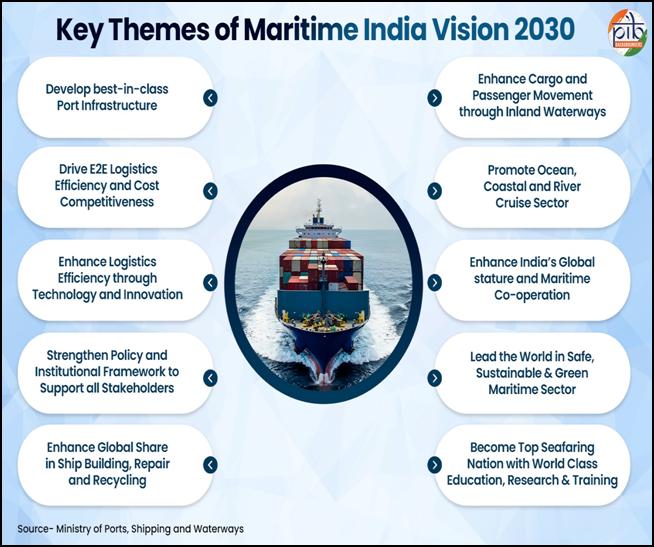India’s maritime sector, the backbone of nearly 95 per cent of the country’s trade by volume and 70 per cent by value, is undergoing a transformative journey under the Maritime India Vision 2030 (MIV 2030) and the ambitious Maritime Amrit Kaal Vision 2047. With over 150 strategic initiatives and projected investments of ₹3–3.5 lakh crore, MIV 2030 is modernizing ports, expanding shipping capacity, and strengthening inland waterways, positioning India as a global maritime powerhouse. Supported by a recent ₹69,725 crore package for shipbuilding, the sector is poised to drive trade, investment, and employment, aligning with India’s economic and sustainability goals.
India Maritime Week 2025, scheduled from October 27 to 31 at Mumbai’s NESCO Exhibition Centre, will showcase this ambition, bringing together stakeholders from shipping, ports, and logistics. Expected to draw over 100,000 delegates from more than 100 countries, the event will feature 500 exhibitors, thematic pavilions, technology demonstrations, and discussions on port-led development, shipbuilding clusters, and digital corridors, fostering collaboration and innovation.
The maritime sector has witnessed remarkable progress over the past decade. Port capacity has nearly doubled from 1,400 million metric tonnes per annum (MMTPA) to 2,762 MMTPA, reflecting significant investments in modernization. Cargo handling has surged from 972 million metric tonnes (MMT) to 1,594 MMT, with major ports managing 855 MMT in FY 2024-25, up from 819 MMT the previous year. Operational efficiency has improved, with vessel turnaround time reduced from 93 hours to 48 hours, boosting global competitiveness. Financial performance has strengthened, with the net annual surplus rising from ₹1,026 crore to ₹9,352 crore, and the operating ratio improving from 73 per cent to 43 per cent.
India’s shipping sector has also expanded, with the number of Indian-flagged vessels growing from 1,205 to 1,549 and gross tonnage increasing from 10 million to 13.52 million. Coastal shipping has doubled cargo movement from 87 MMT to 165 MMT, promoting eco-friendly transport. The inland waterways sector has seen a 710 per cent rise in cargo movement, from 18 MMT in 2014 to 146 MMT in 2025, with operational waterways expanding from three to 29. The Haldia Multi-Modal Terminal in West Bengal, with a capacity of 3.08 MMTPA, has been handed over to IRC Natural Resources under a public-private partnership, enhancing multimodal logistics. Ferry and Ro-Pax services carried over 7.5 crore passengers in 2024-25, reflecting growing public adoption of water-based transport. India’s seafarer workforce has grown from 1.25 lakh to over 3 lakh, now comprising 12 per cent of the global seafaring workforce, making the country a top supplier of skilled maritime professionals.
Financing is fueling this transformation. The Maritime Development Fund, with a ₹25,000 crore corpus, supports long-term financing for shipping and shipbuilding. The revamped Shipbuilding Financial Assistance Scheme, with ₹24,736 crore, addresses cost disadvantages and promotes ship-breaking, while the Shipbuilding Development Scheme, with ₹19,989 crore, drives greenfield clusters and yard expansions. The ₹305 crore Indian Ship Technology Centre in Visakhapatnam will serve as a hub for ship design, research, and skill development. Over ₹1,000 crore has been invested in Northeast India’s inland waterway infrastructure, with ₹300 crore worth of projects completed. Two luxury cruise ships, under construction at Hooghly Cochin Shipyard in Kolkata for ₹250 crore, are set to transform Assam’s river tourism by 2027 under the Cruise Bharat Mission.
The Sagarmala Programme, a cornerstone of MIV 2030 and Maritime Amrit Kaal Vision 2047, is advancing 840 projects worth ₹5.8 lakh crore by 2035, with 272 projects worth ₹1.41 lakh crore completed and 217 projects worth ₹1.65 lakh crore underway. These initiatives aim to cut logistics costs, enhance trade efficiency, and create jobs through sustainable transport networks.
The Maritime Amrit Kaal Vision 2047, with investments of nearly ₹80 lakh crore, envisions India as a top maritime and shipbuilding nation by 2047. It emphasizes green corridors, green hydrogen bunkering, and methanol-fueled vessels to align with global sustainability goals. In September 2025, the “Samudra Se Samriddhi” event saw 27 MoUs signed, unlocking ₹66,000 crore in investments and creating over 1.5 lakh jobs. Key projects include a Greenfield Port at Bahuda in Odisha with 150 MTPA capacity for ₹21,500 crore, a ₹908 crore Water Metro Project in Patna using electric ferries, and a vessel-owning joint venture to reduce reliance on foreign fleets. The New Mangalore Port Authority has launched eight projects, including a dedicated cruise gate and a ₹107 crore multi-speciality hospital, enhancing operational capacity and user experience.
India’s maritime sector is transforming its 7,500-km coastline into a hub of economic opportunity. With a focus on green technologies, digital innovation, and global leadership, the Maritime India Vision 2030 and Amrit Kaal Vision 2047 are steering the nation towards a future where it not only meets its trade demands but shapes global maritime trends, ensuring prosperity and sustainability for generations to come.










